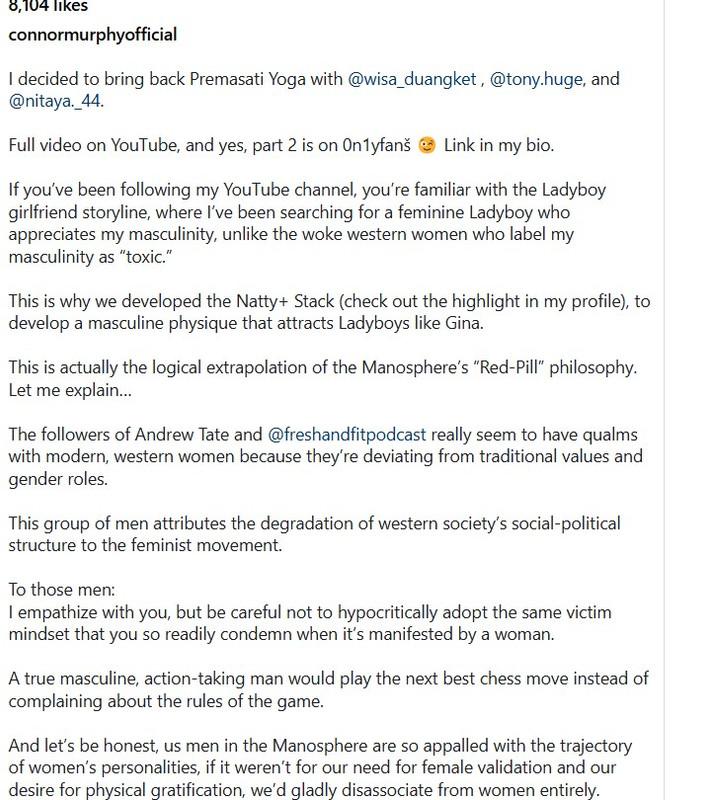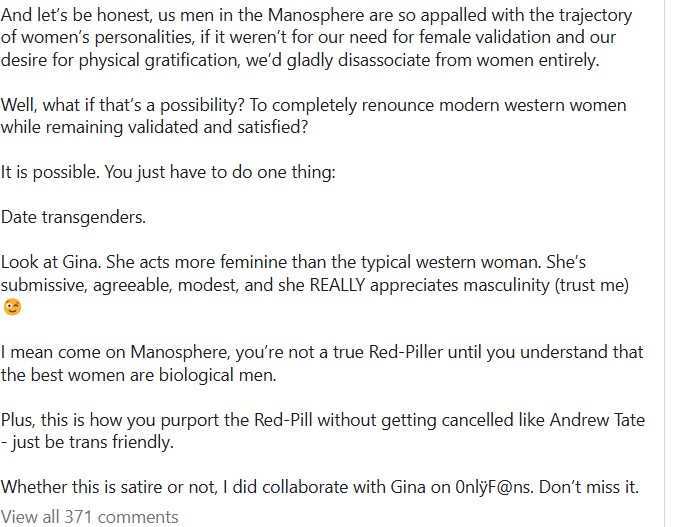What the manosphere and liberal feminism share
There are probably too many
definitions of the “red pill” now to enumerate. But one consistent theme among those who embrace a worldview
dubbed by one progressive as “the heart of modern misogyny” is overt hostility to feminism.
If one of its most prominent advocates is anything to go by, though, the “red pill” should be seen not so much as opposed to feminism as structurally identical to it — just with the poles reversed.
Rollo Tomassi, the “Rational Male”, is a famous (or, if you prefer, notorious) figure in the online manosphere. His prolific
output promises, for the young men who pay to access his teaching, to reveal the secrets of “Game”, which is to say the hidden key to manipulating women into wanting sex with you. This, he asserts, turns on becoming a “high-value male” and thus triggering women’s innate, evolved tendency to desire high-status men.
But what does such a high-value male look like? Tomassi this week
tweeted his cheat sheet for attaining this elusive status. Avoid early marriage; work hard at staying in shape; focus on your career goals; earn lots of money. And, most startlingly of all: neuter yourself in your twenties.
A high-value male, then, is a rich, workaholic, commitment-phobic gym-rat who can’t give you kids. I suppose there must be some women for whom this is an appealing picture, but what struck me about Tomassi’s guidelines are just how startling a resemblance they bear, with superficial adjustments in aesthetic, to this wildly successful classic of liberal pop-feminism, which sold two million copies in its first two weeks: Helen Gurley Brown’s 1962
Sex and the Single Girl.
The book advises women to keep themselves in shape, focus on their careers and social lives, and have as many sexual affairs as they like — especially with married men — until they’re ready (if they ever are) to settle down. At that point, Brown points to her own story to reassure women that they’re sure to find a great man who will admire their success and ambition.
The principal difference between Tomassi’s and Brown’s visions is that Brown promises her readers, with the aid of glowing anecdata, that you can have the singledom, the career, and all the sex
and then get married in your late thirties – at which point you’ll still be able to have all the babies you want, and to hire someone else to take care of them. She was obliged in the end to omit the chapter on birth control; but the Pill, approved by the FDA two years before
Sex and the Single Girl was published, is implicit everywhere. How else is anyone to take seriously a book that celebrates female unmarried promiscuity, while mentioning pregnancy only once?
For Tomassi, meanwhile, even Brown’s optional, high-end, staff-assisted version of professional coupledom is too tied down. “High value” in his vision means foreclosing stable relationships and parental obligation altogether. Later generations of women following in Brown’s footsteps are already there, too: we need only glance at her intellectual descendants, such as the liberal feminist writer Jill Filipovic, to see
paeans of praise to those women who take the Tomassi approach.
But the central takeaway for me is a simple one: that if Tomassi is anything to go by, the “redpill” manosphere worldview is anything but antagonistic to liberal feminism. Both worldviews advocate broadly the same thing, just in pink or blue flavour: an idealised vision of money-grubbing atomisation, in which sexuality is redirected from generation to leisure activity, and life has no broader purpose beyond the optimisation and gratification of self.
Rather than wasting energy taking the side of either liberal feminism or of the “red pill”, we might ask ourselves about the prospects of survival for a culture that grants any credence at all to such literally sterile ideologies.
Mary Harrington is a contributing editor at UnHerd.
What the manosphere and liberal feminism share - UnHerd

 en.wikipedia.org
en.wikipedia.org










